
Tourmalated Quartz: Meanings, Healing Properties, and Powers
 If you love a good artistic silhouette as much as we do, you’ll adore the tourmalated quartz stone! Tourmalated quartz, also called rutilated quartz, is a common variety of clear quartz that contains tourmaline inclusions. The needle-like inclusions are either black or dark green and are sometimes called “schorl.”
If you love a good artistic silhouette as much as we do, you’ll adore the tourmalated quartz stone! Tourmalated quartz, also called rutilated quartz, is a common variety of clear quartz that contains tourmaline inclusions. The needle-like inclusions are either black or dark green and are sometimes called “schorl.”
As an accessory, tourmalated quartz jewelry is neutral enough to match any outfit but far from boring. The stone’s earthy, intriguing look is sure to turn heads and start conversations!
But what does tourmalated quartz mean and does the stone have powers? On that note: what is tourmalated quartz good for in your daily life? We’ll answer all that and more in this complete tourmalated quartz information guide.
SHOP FOR TOURMALATED QUARTZ
What is Tourmalated Quartz?
The name of the stone can be a point of confusion. You may see tourmalated quartz by the name of tourmaline quartz, tourmalinated quartz, or tourmalinated quartz crystal.
Each name refers to the same stone: an included quartz gem with patterns that change from one stone to the next. The inside of a tourmalated quartz stone looks like a picturesque scene of tree branches silhouetted against a white winter sky.
Speaking of winter, tourmalated quartz is a lucky zodiac stone for our winter babies: Capricorns!
Tourmalated quartz stone can help Capricorns achieve their ambitious goals by clearing away obstacles and granting them the mental fortitude to keep pushing forward.
If you’re more into the autumn season than Christmas time, don’t fret. Tourmalated quartz is an alternative birthstone for October!
Why not celebrate your birthday and show off your Halloween spirit by wearing a spellbinding tourmalated quartz bracelet all month long?
Now it’s time to dig into all the scientific details that make the tourmalated quartz stone so bewitching.
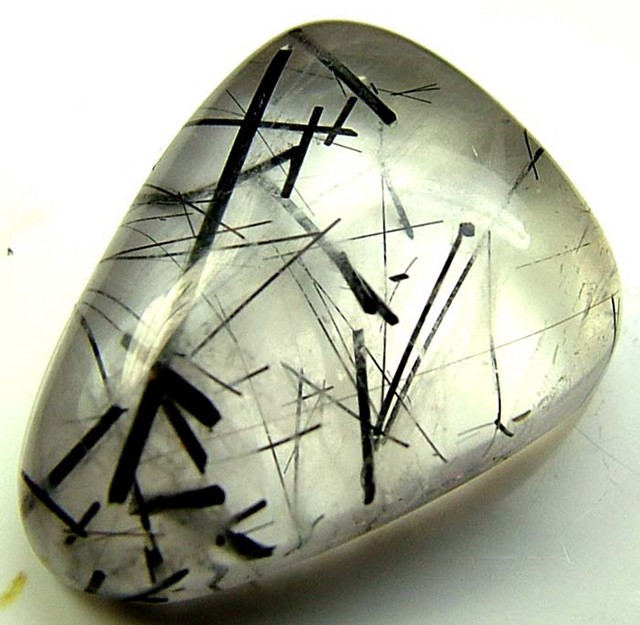 Tourmalated Quartz Stone Specifications
Tourmalated Quartz Stone Specifications
Tourmalated quartz is a type of quartz crystal with long, narrow inclusions of tourmaline. Tourmaline is an umbrella term for boron silicate minerals with the same structure but slightly varying chemicals.
While tourmaline is a stone of many faces, the three primary forms are schorl, dravite, and elbaite. Schorl, or black tourmaline, is what you’ll find within tourmalated quartz.
Tourmaline inclusions aren't limited to clear quartz, however. Other varieties of quartz that can contain tourmaline include citrine (yellow quartz) and smoky quartz.
For the rest of tourmalated quartz’s characteristics, here is the complete list:
Chemical compound: Silicon dioxide (quartz) and boron silicate (tourmaline inclusions)
Mohs scale: 7
Color: Colorless; Black or dark green inclusions
Crystal structure: Trigonal
Luster: Vitreous (glass-like)
Transparency: Translucent to transparent
Refractive index: 1.54-1.55
Density: 2.64-2.69
Cleavage: None
Tourmalated quartz is just one of the many included quartz stones. Other examples include rutilated quartz, epidosite, mica quartz, and pyrite quartz. Each different inclusion brings its own spiritual properties to the stone.
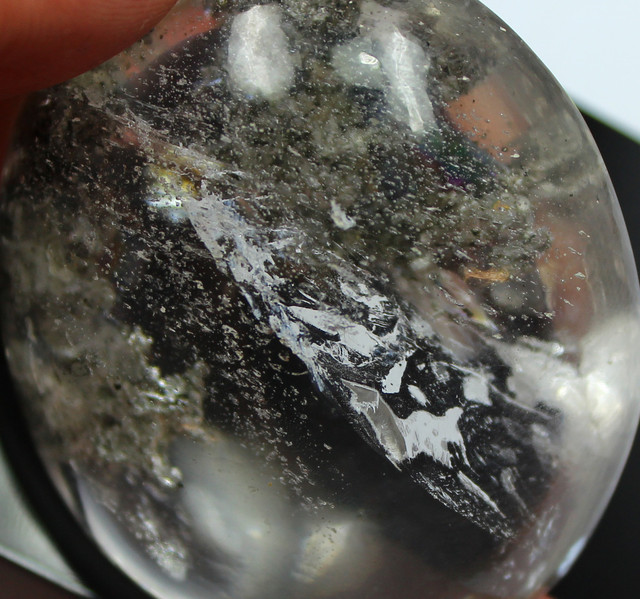
Tourmalated Quartz Meaning
The name “tourmaline” comes from the word tōramalli, a Sinhalese term meaning “mixed gems.” The word tōramalli was the Sri Lankan way of referring to any colored gemstone.
“Tourmaline” wasn’t used for the specific mineral until 1766, when Swedish mineralogist Sven Rinmann officially identified it.
Scholars aren’t 100% sure where the word “quartz” comes from, but the most likely etymology is the word querklufterz. Querklufterz derives from a language used in the Middle Ages called Old Saxon, and it means “cross vein ore.”
Clear quartz is a symbol of abundance and purity. It’s often seen as a pillar of light, sometimes symbolizing the sun itself and the vitality it provides.
Now, tourmaline meaning is tied to grounding and mindfulness. The same applies to tourmalated quartz meaning. Mindfulness is a transformative holistic modality that can actually change your brain chemistry for the better! Besides, getting lost inside tourmalated quartz’s mesmerizing patterns is a great way to unwind.
In Feng Shui, tourmaline can cleanse and purify a space. Clear quartz’s benefits in feng shui include harmonizing and amplifying energies. The same goes for any gemstone, so clear quartz can amplify tourmaline’s cleansing properties to create the perfect zen zone.
Moreover, tourmaline is considered a lucky stone, so amplify that with clear quartz? You get a perfect good luck charm in the tourmalated quartz stone!
Tourmalated quartz’s symbolism ties into its myriad of benefits, if you know how to use it. So how do you use tourmalated quartz?
Tourmalated Quartz Spiritual and Healing Properties
Tourmalated quartz is a healing stone for grounding, protection, and balance. These properties interweave together to keep you present while protecting you from any negativity swirling around you.
For physical healing, tourmalated quartz can help with digestive issues like heartburn or the stomach flu. Additionally, the stone is purported to help restore the nervous system and heal wounds.
Do you tend to absorb other people’s emotions? Tourmalated quartz can help you balance your natural empathy. By soaking up negative energies, tourmalated quartz can help you feel less overwhelmed. The stone’s grounding properties are a great tool for empaths, who can further benefit from practicing mindfulness in their day-to-day life.
Mindfulness and meditation often go hand in hand. One of the best methods for spiritual meditation? Chakra healing!
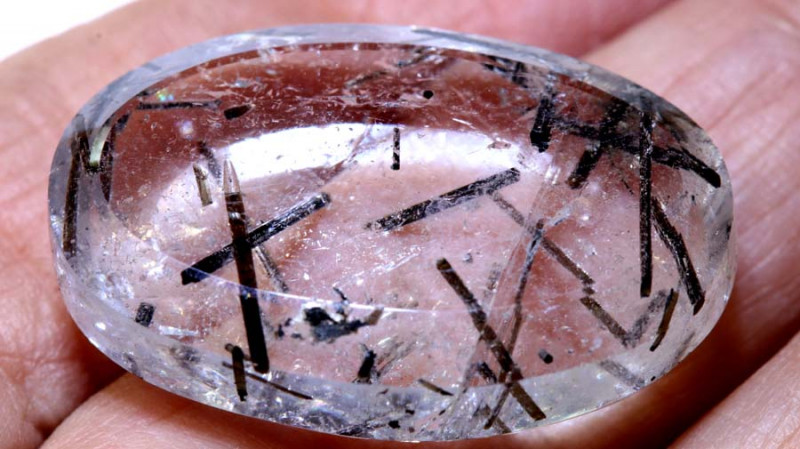
What chakra is tourmalated quartz associated with?
Tourmalated quartz stone aligns with two chakras: the base chakra and the third eye chakra.
The base chakra, or root chakra, rules our fundamental needs and connection to Earth. By connecting the individual self to the world, the base chakra is great for manifestation and grounding.
How will you know if this chakra is blocked? You may find yourself feeling disconnected, worried, or fatigued. Tourmalated quartz balances the chakra, allowing you to trust your intuition and embrace your true self.
The third eye chakra, or brow chakra, is at the center of the forehead and rules our intuition and awareness.
If you’re unfamiliar with the third eye chakra, this is the energy center that increases self-awareness and encourages us to follow our instincts. When it’s blocked, we might experience self-doubt or self-sabotage. When tourmalated quartz opens the chakra, our insecurity can be replaced by openness to new experiences and self-reflection.
For the more spiritual folks, this chakra can help you access psychic abilities and communicate with your spiritual guide. Tourmalated quartz can balance the third eye chakra to allow for practicing astral travel and peaking into past lives.
Speaking of looking into the past, let’s take a peek at the history of tourmalated quartz!
Tourmalated Quartz Stone History
While it’s unclear when tourmalated quartz was first discovered, tourmaline and quartz each have fascinating histories.
The history of quartz goes way back. We’re talking 2 million years back. Archeologists have found evidence that early humans in Africa, or hominids, used quartz to create sharp tools. As humans evolved, so did our methods for using quartz.
Indigenous groups have used quartz to make fire, engrave rocks, and wear as talismans for good luck or divination.
Ancient Greeks, notably Theophrastus and Pliny the Elder, believed quartz crystals were special forms of ice. They used the word crystal — quartz wasn’t used until 1505 — but modern scholars have concluded that they were referring to quartz.
When did the timeline of tourmaline begin?
Not quite two million years ago, tourmaline emerged later in the 1500s when a Spanish conquistador named Francisco Spinoza found a tourmaline stone in Brazil. However, since it was an unknown gem, he initially thought it was an emerald.
In the 1700s, Dutch gemstone traders made the same mistake when they discovered tourmaline in Sri Lanka and sold it as emerald. The Dutch did accidentally discover one of tourmaline’s most intriguing qualities, however: its pyroelectric properties.
When Dutchmen heated the stone, it could attract ashes in their tobacco pipes through magnetism. Once cooled, the stone would repel the ashes. Talk about style and function!
Over in the west, Native Americans used tourmaline for ages, notably during protection rituals and within their graves. However, tourmaline didn’t gain notoriety in America until Tiffany gemologist George F. Kunz wrote about it in 1883.
While Americans loved the new tourmaline gem, most of our tourmaline gems went to China. The Empress Tz’u Hsi adored the pink tourmalines mined in California, so she had them imported for snuff bottle carvings and jewelry settings.
On the subject of mines, let’s discuss where tourmalated quartz stones come from.

Tourmalated Quartz Origins and Sources
Tourmalated quartz’s formation is similar to most quartz stones. With high heat and pressure underground, quartz minerals melt into a liquid state. Other minerals nearby melt as well — in this case, tourmaline.
From there, the liquid minerals mix together. As the pressure and temperature decrease, the stones harden together, creating the beautiful inclusion patterns we see in the tourmalated quartz stone.
The formation process happens deep within the ground before the gems are mined and polished into gorgeous gemstones. But where is tourmalated quartz found in the world?
Mining Locations
Most of the tourmalated quartz stones used in jewelry come from Brazil. Ethiopia, India, and Tanzania boast prominent tourmalated quartz deposits as well.
Other countries where tourmalated quartz is found include:
Sri Lanka
Madagascar
Argentina
Canada
South Australia
United States (mostly in California and Nevada)
No matter where the tourmalated quartz stone comes from, you’ll want to know the basic buying factors before purchasing your own. We’ve got you covered!
Tourmalated Quartz Gemstone Properties
Anytime you’re buying goods, especially if you buy gemstones online, it’s important to do your research. After all, an educated shopper is a smart shopper. When you’re buying gemstones, it’s essential to know the key traits that determine their value. Let’s take a look.
Color
While tourmaline stones come in the broadest color range of any gemstone, tourmalated quartz stones generally stick to a couple of dark hues.
For the most common tourmalated quartz base, clear quartz, the tourmaline inclusions are mostly black or dark green. If the quartz stone is colored, like citrine or smoky quartz, the tourmaline inclusions may appear black, light green, dark orange, or even purple.
Clarity
Typically, gemstones with inclusions have a lower value than gemstones without inclusions. However, tourmalated quartz stones are admired for their inclusions, so the more interesting inclusion patterns lead to a higher value.
Based on the colored gemstone grading scale, tourmalated quartz would fall under the Type III clarity grade.
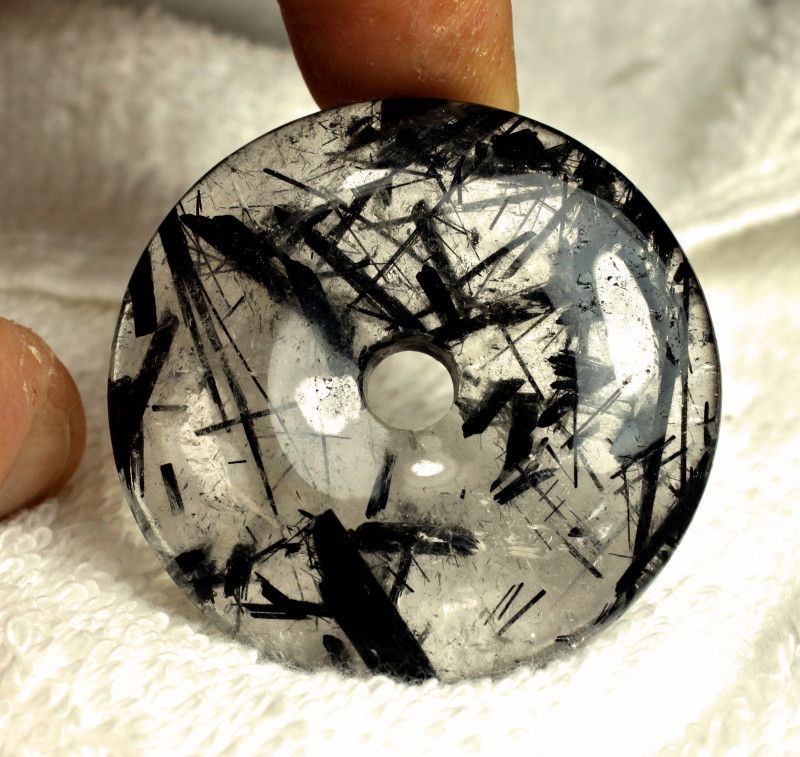
Cut
Tourmalated quartz’s strength lends itself to any common gemstone cut. Popular faceted cuts for tourmalated quartz include oval, round, and rose cuts. However, it most often becomes beads or cabochons because this cut shows off its intricate inclusions best.
Carvings are another popular way to display tourmalated quartz stones. Decorative elements such as animal figurines, intaglios, or crystal points are a great way to bring tourmalated quartz’s beauty and protection into any space.
The versatility of tourmalated quartz means it’s a perfect stone for both masculine and feminine accessories. Why not gift a protective tourmalated quartz necklace to your partner? It’s a great way to remind them that you’re always there to make them feel safe, even when you’re far away.
You’ll want to keep your tourmalated quartz stone safe too, right? Next, we’ll tell you how to do just that.
Tourmalated Quartz Stone Care and Maintenance
Tourmalated quartz is tough enough to handle most cleaning methods. The stone can even withstand an ultrasonic cleaner. However, we recommend staying on the safe side and sticking to warm water and soap.
To keep their appearance from changing, be sure to store your tourmalated quartz stone away from direct sunlight and harsh chemicals.
If you’re wondering how to cleanse tourmalated quartz, here are our top suggestions:
Bury the stone in the soil of a healthy plant. Leave for 2-3 hours.
Use the smoke from a sage stick to smudge the crystal.
Give the crystal a cleansing moon bath by leaving it under moonlight overnight.
Wondering how much tourmalated quartz costs? Keep reading for answers.
Tourmalated Quartz Price and Value
Tourmalated quartz is an abundant and affordable gemstone, so how much do they cost?
Tourmalated quartz stones with faceted cuts cost between $3-$9 per carat. Some retailers might charge higher prices — anywhere from $10-$160 per carat.
Cabochons and beads have even better prices than faceted cuts. Most tourmalated quartz cabochons will be $0.20-$0.50 per carat.
If you’re a gemstone collector, you may be looking for rough pieces. Rough tourmalated quartz cost about as much as cabochons or beads, at $0.20-$0.75 per carat.
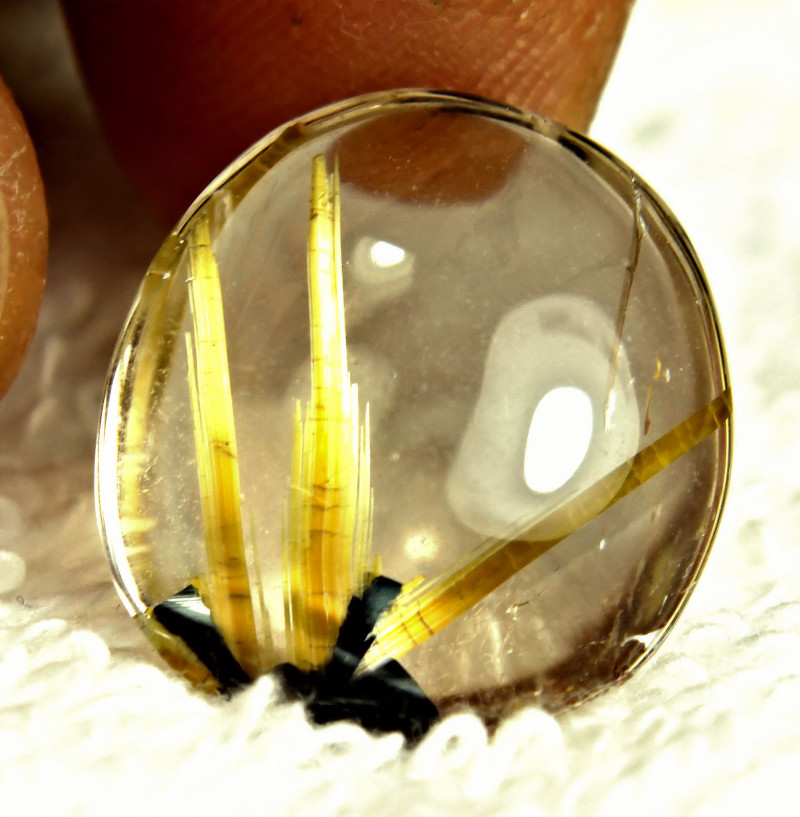
Shopping for Tourmalated Quartz Stones?
Now you know everything you need to know about the tourmalated quartz stone! This gem combines the powers and properties of quartz and tourmaline. The result is a one-of-a-kind stone perfect for grounding and mindfulness exercises.
Could you use more protection or balance in your life? How about some self-reflection? Tourmalated quartz has you covered.
Take it from famed psychologist Abraham Maslow: “What is necessary to change a person is to change his awareness of himself.”
Start practicing grounding today with a tourmalated quartz stone!
Search the Gemstone Encyclopedia
Related Auctions
Related Articles
Azotic treatment of Topaz and Quartz is a treatment that creates a layer of color over a gemstone. Learn more about this treatment and check out our stones fro sale.
8th May 2018
Quartz and Topaz are two of the most common minerals on the planet. They also look very similar. Let's look at some properties of them and compare Quartz and Topaz.
23rd Oct 2018
Gemstones and crystals are capable of absorbing and conveying energy, that’s why it’s important to cleanse, re-charge and program your stones so that they may achieve their best potential.
9th May 2018
Latest Articles
Tantalite is a group of red, brown, or black minerals containing the rare and valuable element tantalum. Discover the uses, history, prices, and properties of tantalite gemstones in this guide!
11th Nov 2024
Hodgkinsonite is a very rare collector’s gemstone known for its vibrant pink or purple hues, only found in New Jersey, USA. Learn hodgkinsonite’s prices, history, properties, and traits in this guide!
9th Jun 2024
Canasite is a rare mineral usually found as greenish-yellow inclusions in charoite but also known as a purple gemstone. Learn canasite’s history, varieties, properties, and prices in this guide.
27th May 2024
Article Categories
How To's is where you will find helpful articles from gem Rock Auctions on how to cut gemstones, select gemstones and buy gemstones.
9 Articles





